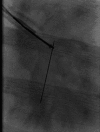Respiratory-aspirated 35-mm hairpin successfully retrieved with a Teflon® snare system under fluoroscopic guidance via a split endotracheal tube: a useful technique in cases of failed extraction by bronchoscopy and avoiding the need for a thoracotomy
- PMID: 22919019
- PMCID: PMC3487096
- DOI: 10.1259/bjr/45761403
Respiratory-aspirated 35-mm hairpin successfully retrieved with a Teflon® snare system under fluoroscopic guidance via a split endotracheal tube: a useful technique in cases of failed extraction by bronchoscopy and avoiding the need for a thoracotomy
Abstract
Respiratory foreign body aspiration (FBA) is a common global health problem requiring prompt recognition and early treatment to prevent potentially fatal complications. The majority of FBAs are due to organic objects and treatment is usually via either endoscopic or surgical extraction. FBA of a straight hairpin has been described as a unique entity in the literature, occurring most commonly in females, particularly during adolescence. In the process of inserting hairpins, the pins will typically be between the teeth with the head tilted backwards, while tying their hair with both hands. This position increases the risk of aspiration, particularly if there is any sudden coughing or laughing. To our knowledge, this is the first case report of a 35-mm straight metallic hairpin foreign body that has been successfully retrieved by a radiological snare system under fluoroscopic guidance. This was achieved with the use of a split endotracheal tube, and therefore avoided the need for a thoracotomy in an adolescent female patient.
Figures






References
-
- Zur KB, Litman RS. Pediatric airway foreign body retrieval: surgical and anesthetic perspectives. Paediatr Anaesth 2009;19Suppl 1:109–17 - PubMed
-
- Baharloo F, Veyckemans F, Francis C, Biettlot MP, Rodenstein DO. Tracheobronchial foreign bodies: presentation and management in children and adults. Chest 1999;115:1357–62 - PubMed
-
- Debeljak A, Sorli J, Music E, Kecelj P. Bronchoscopic removal of foreign bodies in adults: experience with 62 patients from 1974–1998. Eur Respir J 1999;14:792–5 - PubMed
-
- Al-Ali MA, Khassawneh B, Alzoubi F. Utility of fiberoptic bronchoscopy for retrieval of aspirated headscarf pins. Respiration 2007;74:309–13 - PubMed
-
- Li Y, Wu W, Yang X, Li J. Treatment of 38 cases of foreign body aspiration in children causing life-threatening complications. Int J Pediatr Otorhinolaryngol 2009;73:1624–9 - PubMed
Publication types
MeSH terms
Substances
LinkOut - more resources
Full Text Sources
Medical

